#unmanipulated photography
Explore tagged Tumblr posts
Text

Albarran Cabrera —– Instagram
Opticks
Polarized #55454 "Mountain and lake", Pigments, gampi paper and gold leaf
#polarized#abstract photography#birefringence#concrete art#straight photography#unmanipulated photography#albarrancabrera#albarran cabrera#artists on tumblr#photographers on tumblr
218 notes
·
View notes
Text



So I'm telling you,
{ indie roleplay and character exploration blog for gaius van baelsar from final fantast xiv, written by ghost. triggering and mature content present, multiple verses available. read the rules. 18+ only. }
-- that you'll be safe with ME.

#skull tw#body horror tw#gore tw#rose photography by a.drian r.egeci. original unmanipulated skull photograph by l.ina wh.ite#self promo#ffxiv rp blog#final fantasy rp#mry chrsms
4 notes
·
View notes
Text
Notes on Photography and Accident - Reflection
Three things in the reading struck me, or at least have me questioning my relationship with making an image. First, I thought about documentation through writing, thoughts, ideas, and note-taking. Barthes: "When a certain amount of time's gone by without any note-taking, without my having taken out my notebook, I notice a certain feeling of frustration and aridity… it's like a drug, a refuge, a security… Note-taking gives me a form of security." I found this strangely relatable; I always have had to dump all my thoughts and plans into something to get things out of my head onto a physical document to remember. I believe that how I approach photography is an introspection. Davey quotes Sontag and Barthes' "A photograph could also be described as a quotation, making a book of photographs like a book of quotations."… What each reveals, unequivocally, is the "that has been".' Perhaps photographs are visual documentation, a diary of reflections, questions, and ideas; sometimes, the words written in a notebook manifest into an image or vice versa. It's a documentation of the past brought to life.
On page 103, Davey discusses Sontag's thought on how unmanipulated photographs are inherently surreal, that technical skills kill the intrigue within the image. To some extent, the photos I have yet to think twice about and created without thought but through intuition are images I've been drawn towards. However, there must be some planning or preparation with these instinctual practices of creating an image. We know what we are looking for subconsciously well before the image is made or presented itself.
-Arno



0 notes
Text
See Surprisingly Stunning Views From An Airplane Window Seat!
— Photograph By Julieanne Kost

SOUTHERN ICELAND 🇮🇸! Kost considers a few factors before taking off. When possible, she recommends choosing seats that are in front of the engines to avoid distortions caused by the jet’s exhaust and wearing dark clothing to minimize window reflections.

VALLEY OF FIRE STATE PARK, NEVADA, USA 🇺🇸! Named for its striking red Aztec sandstone formations, the Valley of Fire State Park, Nevada’s oldest and largest park, sits 50 miles northeast of Las Vegas and is a popular hiking and photography destination.
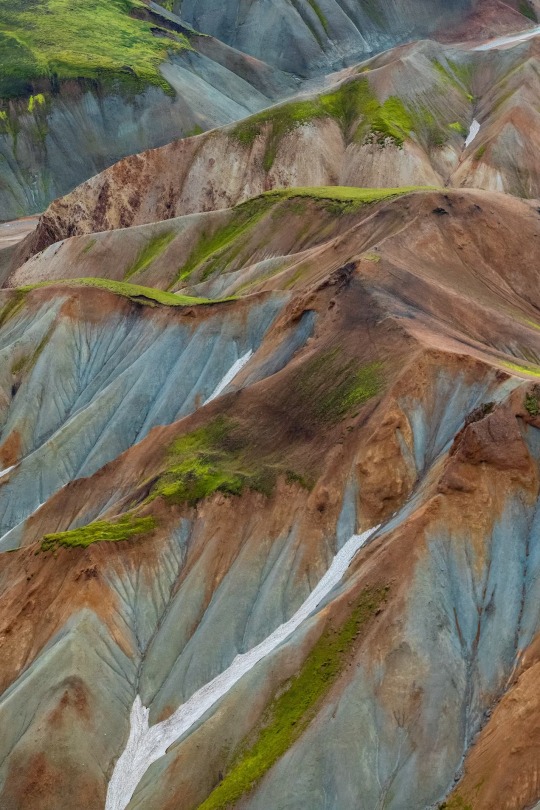
LANDMANNALAUGAR, ICELAND 🇮🇸! The colorful rhyolite mountains in Landmannalaugar, located inside Fjallabak Nature Reserve, hide pockets of geothermal hot springs that are open for a relaxing dip.
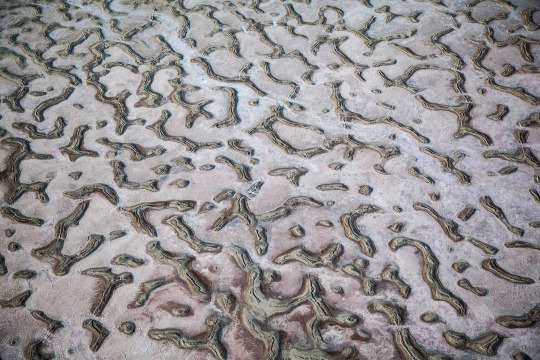
GREAT SALT LAKE, UTAH, USA 🇺🇸! Great Salt Lake’s shoreline is a hot spot for migratory birds, such as the tundra swan, American white pelican, white-faced ibis, California gull, eared grebe, peregrine falcon, and bald eagle.
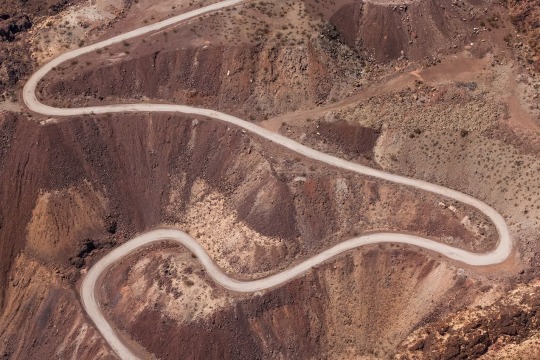
MOJAVE DESERT, NEVADA, USA 🇺🇸! When photographing through an airplane window, Kost says avoid using a polarizing filter. Most commercial airplane windows have a coating that reacts with polarizing filters, resulting in images with artificial-looking colors.
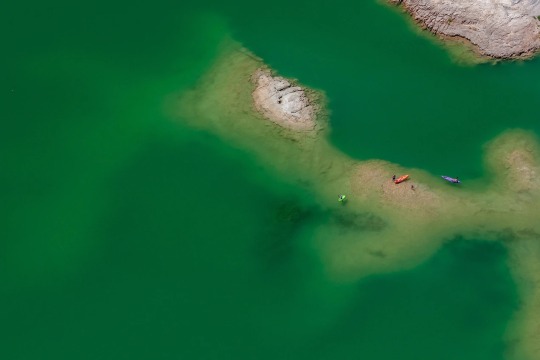
LAKE MEAD NATIONAL RECREATION AREA, NEVADA, USA 🇺🇸! With three deserts and views of Hoover Dam, Lake Mead National Recreation Area became the country’s first congressionally designated National Recreation Area in 1964.
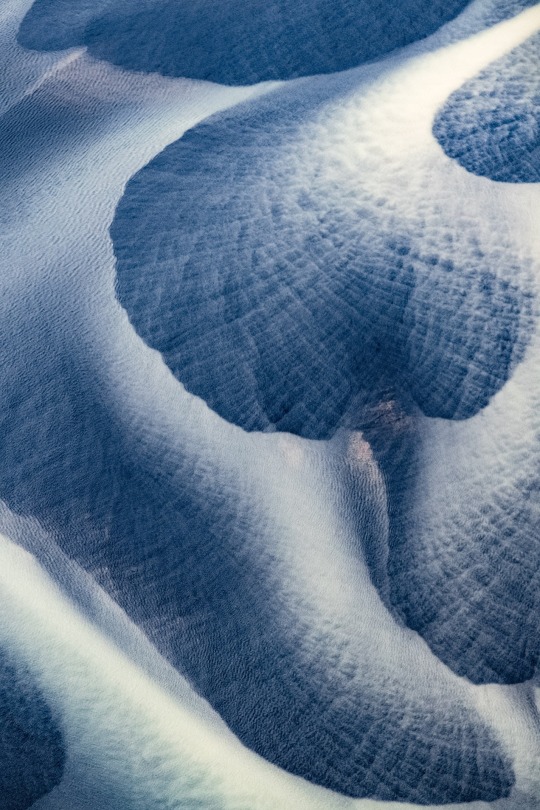
SOUTHERN ICELAND 🇮🇸! “I’ve always been drawn to photographs of ice,” says Kost. Here, Kost captures the frozen landscape of a country that is 11 percent ice.
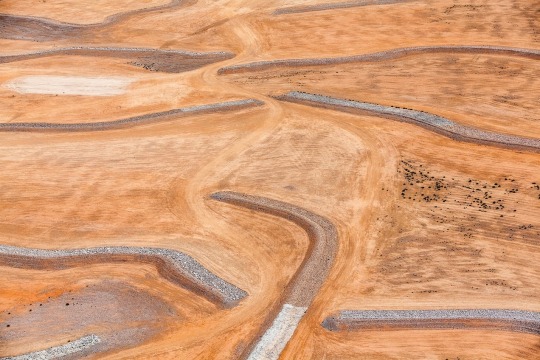
LAS VEGAS, NEVADA, USA 🇺🇸! When taking a window-seat photograph, Kost suggests using the widest aperture setting on your camera to help minimize the appearance of dirt or scratches on the window.

GREAT SALT LAKE, UTAH, USA 🇺🇸! One of the largest saltwater lakes in the western hemisphere, the Great Salt Lake’s salinity levels—nearly four to 10 times the ocean’s—keep swimmers buoyant in its warm, shallow waters.

SAN FRANCISCO BAY, CALIFORNIA, USA 🇺🇸! These unmanipulated images from Kost’s window seat help change perspectives and encourage travelers to leave the shades open. In this photo, microorganisms brighten up the San Francisco Bay salt ponds with vibrant colors.
0 notes
Photo

it's hard
to stay within the purely artistic photography with such a lovely natural model that literally has everything one could wish. But (despite of some very personal videos and lots of totally shameless and explicit shots) I still tried to portray this marvelous young girl artistically in many large photo sessions. All of them can be seen without any censorship or shyness on my
https://www.patreon.com/danielbauer
With your support - from 1$ - you help me to continue creating artistic erotic nudes of my personal, special kind of photography: authentic images that are unmanipulated and show the marvelous young women as they really are from their most pretty, most sensual and often most salacious sides.
I work with very natural and beautiful amateur models who truly enjoy to show themselves to me and you and their happy and unashamed zest for life is so very obvious in the images that you can feel it.
Please take a look. Thank you!
#Daniel Bauer#bush#fur#hairy girls#hairy#unshaven#bodyhair#bodyhairdontcare#lovely#model#nofilter#art photography
1K notes
·
View notes
Photo

George Rodger, Kerzaz palms near the Grand Erg Oriental, Sahara Desert, Algeria, 1957. "You must feel an affinity for what you are photographing. You must be part of it, and yet remain sufficiently detached to see it objectively. Like watching from the audience a play you already know by heart"- George Rodger "...Although Rodger originally viewed photography as a supplement to his documentary writing, he came to accept the descriptive value and emotional force of the medium as vital to his stories. In order to represent his experiences accurately, he committed himself to producing straight, unmanipulated photographs that he described as "honest and true." As one of the first European photographers to produce extensive reportage in Africa during the immediate postwar years, Rodger made photographs that provided Westerners access to an unfamiliar but increasingly important area of the world..." https://www.instagram.com/p/CIBoGuGAJj-/?igshid=ei7cd9rpoaz0
297 notes
·
View notes
Photo

Protest against Islamaphobia and the rise of white supremacy.
#Toronto#islamaphobia#Protesters#love#CNTower#us embassy#powerinnumbers#TheRestOfCanada#35mm photography#unmanipulated
2 notes
·
View notes
Photo

Celebrating July 14 #bastilleday at #apggallery #opening on July 13 with 3 of my #unmanipulated #photography with a #very good #turnout for a heavy US #week end #departure #summertime #summerphotography #womenartistes #womenartists @frenchdistrict #frenchintheusa @frenchupyourlife @franceatlanta @franceintheus #lens #aperture #aperturefoundation #rps #atlanta #atl #atlantaisnow #digitalphotography #nophotoshop https://www.instagram.com/p/Bz6Vyvfp-D_/?igshid=x83g5lz5tnup
#bastilleday#apggallery#opening#unmanipulated#photography#very#turnout#week#departure#summertime#summerphotography#womenartistes#womenartists#frenchintheusa#lens#aperture#aperturefoundation#rps#atlanta#atl#atlantaisnow#digitalphotography#nophotoshop
0 notes
Note
Hey I know you don’t get much attention on here, you deserve all my followers!!! Your photography is great!! Can I save one of your pictures to my phone as a widget? 🥺
Sure! Thank you so much, not just for the compliment but for asking. I’m good with most anything folks want to do as long as they don’t claim credit or profit from it, but I really appreciate you asking first.
As for the followers, well, I probably have the right amount. I don’t post fandom related stuff, almost never reblog (just ‘cause I want the blog to be clearly my own “stuff”... maybe I should have a side blog), and even my photos in the woods are just whatever I see, unmanipulated and, TBH, rather repetitive. I am grateful anyone wants to follow me!
Sorry if this ask has been waiting a while. I just noticed it because I don’t always get notifications of asks. Not that my notifications for comments and messages are any more reliable...
6 notes
·
View notes
Text
Exceptional Collection of Paul Strand Works Highlights Bonhams New York Photography Sale in October
Exceptional Collection of Paul Strand Works Highlights Bonhams New York Photography Sale in October
Photographs11 Oct 2022New YorkPaul Strand(1890-1976)Central Park, New York New York – An unprecedented single-owner collection of 13 works by Paul Strand (1890-1976) will be offered at Bonhams’ Photography sale on October 11 in New York. One of the most influential photographers of the 20th century, Strand was a popularizer of ‘straight photography’ – an unmanipulated style which emphasizes…

View On WordPress
0 notes
Video
instagram
Unmanipulated flourish Capital Demonstration using Automatic pen Italic workshop in Saigon last month . #huyhoangdao #calligraphy #penmanship #handwriting #lettering #typography #flourishing #birdflourishing #copperplate #spencerian #pointedpen #obliqueholder #iampeth #vsco #photography
#calligraphy#handwriting#typography#huyhoangdao#spencerian#lettering#flourishing#penmanship#photography#obliqueholder#birdflourishing#iampeth#vsco#pointedpen#copperplate
9 notes
·
View notes
Text
History of Photography (1850-1950)
1850- Daguerreian and Photogenic Arts is published in New York. It is the world’s first photographic journal. Blanquart-Evrard proposes use of albumen for printing paper. Albumen paper was never patented and was popularly used for 40 years.
1861- Oliver Wendell Holmes invents stereoscope viewer. Felice Beato arrives in Japan to produce photos of “native types”. Carlton Watkins makes his first photographic expedition into the Yosemite Valley
1870- Henri Le Secq publishes architectural view photolithographs made from his paper negatives created in the early 1850’s. Allan Pinkerton creates a collection of photographs of known criminals to aid in the work of his detective agency.
1880- A craze for photographs made on the sly took hold in the 1880s, leading to ever-smaller “detective” cameras and more ingenious disguises for cameras. The first halftone photographic reproductions appear in a daily newspaper, the New York Daily Graphic
1890- George Davison exhibits The Onion Field in the royal Photographic Society’s Annual Exhibition. This image taken with a pin-hole camera and printed on rough paper heralded the beginning of impressionistic photography.
1900- Frederick H Evans exhibits 150 platinum prints at the Royal Photographic Society. Evans was known as a prime exponent of ‘pure photography’: images that are unretouched and unmanipulated
1910- Alvin Langdon Coburn publishes portfolios of photogravures devoted to London and New York. Starting at age 6 (in 1900) , Jacques Henri Lartigue begins photographing his own life and the people and activities in it.
1920- Film stills become popular in the promotion of movies. Sometimes called publicity stills, they are photographs taken on the set of a movie during production.
1932- The Group f/64 is created. The name the very small lens aperture used to increase sharpness and depth of field. The members, including Ansel Adams, Edward Weston, and Imogen Cunningham, are committed to defining photography as a pure art form rather than a derivative of other art forms. Henri Cartier-Bresson buys a Leica and begins a 60-year career photographing people
1941- Eastman Kodak introduces Kodacolor negative film.
1950- Paul Strand left the U.S., a departure that marked the beginning of his long exile from the prevailing climate of McCarthyism. The remaining 27 years of his life were spent in Orgeval, France where, despite never learning the language, he maintained an impressive creative life, assisted by his second wife, fellow photographer Hazel Kingsbury Strand.
5 notes
·
View notes
Text



László Moholy-Nagy (3/4)
László Moholy-Nagy (1895- 1946) was a Hungarian painter and photographer as well as a professor in the Bauhaus school. Similar to Alexander Rodchenco, he was heavily influenced by constructivism. He was also a strong advocate of the integration of technology and industry into the arts.
His influence been greater than in photography. He had a deep interest in the photogram and the photomontage, techniques that stood as a halfway house between photography and painting. His photography was extremely interesting and distinctive in the technical sense that the pictures were unmanipulated prints of images recorded by the camera.
0 notes
Photo

Berenice Abbott
Berenice Abbott, born in 1898 – 1991, was an American photographer best known for her portraits of between-the-wars 20th century cultural figures, New York City photographs of architecture and urban design of the 1930s, and science interpretation in the 1940s to 1960s.
Abbott was part of the straight photography movement, which stressed the importance of photographs being unmanipulated in both subject matter and developing processes
0 notes
Text
Understanding Movies (Seventh Edition)
By Louis Giannetti ISBN 0-13-190836-7
1 - Photography pg.2
Realism and Formalism
“Three styles of film: realism, classicism, and formalism.” “Realism is a particular style, whereas physical reality is the source of all the raw materials of film, both realistic and formalistic.” In both realistic and formalistic films, certain details must be selected to emphasise; the element of selectivity isn’t as obvious in realistic films. Realism - trying to preserve the illusion that their film world is unmanipulated; an objective mirror of the real world. Style isn’t often noticed, more focus on what’s shown than how it is manipulated. Simplicity, spontaneity, and directness. Art that conceals art. A documentary image usually gets its emotional impact from it’s truth not beauty. Formalism - deliberate stylisation and distortion of raw materials. Expression of subjective experience of reality. “Expressionists are often concerned with spiritual and psychological truths, which they feel can be conveyed best by distorting the surface of the material world.” High degree of manipulation, re-forming reality. Avant-garde cinema, abstract. Form and content aren’t so clear-cut.
“One way of understnading better what a film is trying to say is to know how it is saying it.” André Bazin pg.7 Theory of organic form - the belief that form and content are mutually dependent in flm as well as any other kind of art.
“The way a story is told is part of that story. You can tell the same story badly or well; you can also tell it well enough or magnificently. It depends on who is telling the story.” Herman G. Weinberg pg.7
The Shots
Different cinematic shots are defined by the amount of subject matter that is included within the frame. In general, decided by how much of the human figure is visible. 1. The extreme long shot. 2. The long shot. 3. The full shot. 4. The medium shot. 5. The close-up. 6. The extreme close-up. 7. The deep focus shot (usually a variation of the long and extreme long shot.)
1. From a great distance. Almost always an exterior shot. Spatial frames or reference for closer shots - establishing shots. Often seen in epic films, where locale plays an important role. 2. Ranges correspond approximately to the distance between the audience and the stage in the live theatre. The closest range is the full shot, just barely includes the human body in full - head near the top of the frame and feet near the bottom. Charlie Chaplin favoured the full shot because best suited to pantomime yet close enough for face. 4. Figure from the knees or waist up. Useful for expostion scenes, carrying movement and dialogue. The two shot - two figures waist up. Three shot - three figures. More than three - tends to be a full shot. The over-the-shoulder shot usually contains two figures, one with part of their back to the camera, the other facing the camera. 5. Very little if any locale. Concentrates on a relectively small object - human face. Due to magnification, tends to elevate the importance. Symbolic significance. Extreme close up is a variation of this. Only a person’s eyes or mouth. 7. Consists of a number of focal distances and photographed in depth. Sometimes called a wide angle shot (uses wide angle lens). Objects at close, medium and long ranges simultaneously, all in sharp focus. Director can guide the eye from one distance to another. Close across to long.
The Angles
The angle is defined by the placement of the camera, not the subject photographed. This can act as commentary on the subject matter - the angle can represent the significance. In realism, extreme angles to tend to be avoided with most scenes being at eye level, roughly five to six feet off the ground; the way an observer might see the scene. Eye level shots aren’t usually dramatic because they tend to be the norm. The realist wants to make the audience forget the camera. “Formalist directors are not always concerned with the clearest image of an object, but with the image that best captures an object’s expressive essence.” Extreme angles involve distortion. This can be a source of symbolism in the imagery. The formalist calls attention to the presence of the camera.
There are five basic angles: 1. The bird’s-eye view. 2. The high angle. 3. The eye-level shot. 4. The low angle. 5. The oblique angle.
Generally speaking, the more extreme the angle, the more distracting and conspicuous it is in terms of subject matter.
1. Bird’s-eye view. Could be considered most disorienting. Photographing a scene from directly above. Unrecognisable and abstract because we rarely see from this angle. Hover above a scene like an all powerful god; the people photographed seem antlike and insignificant. 2. High angle shot. Less extreme. Camera is placed on a crane or a natural high promontory. Sense of general overview. Ground or floor is usually the background. Movement is slowed down; this angle isn’t ideal for depicting speed. Useful for suggesting tediousness. High angles reduce the importance of a subject. The importance of setting and environment is increased. Also effective for showing a characters self-contempt. 3.Eye-level shot. Lets the audience decide which characters are important. Puts the viewer at the same level, equality between characters, preventing them from being seen condescendingly or sentimentally. 4. Low angles have the opposite effect of high. Increase of height so useful for suggesting verticality. Increase a short actors height. Motion is speeded up and in scenes of violence particularly, creates a sense of confusion. Environment is minimised, sky or ceiling is often the only background. Psychologically increases the importance of a subject. Figure looms menacingly over the spectator, who is made to feel insecure and dominated. Low angles often used in films of propaganda and scenes showing heroism. 5. Oblique angle involves a lateral tilt of the camera. When the image is presented, the horizon is skewed. A man will look like he is about to fall to the side. This angle is sometimes used for point of view shots. eg. suggest imbalance of a drink. Psychologically suggest tension, transition, and impending movement. Natural horizontal and vertical lines are converted into unstable diagonals. Not often used as they can disorient a viewer. This sense of visual anxiety can be good for showing violence.
0 notes
Text
- LECTURE 4 -
NEW AND OLD WORLDS : Photography & Modernism
American Modernism
· ‘Straight’ - American modernist photography.
· Stieglitz promoted modernist photography, straight, unmanipulated and documentitive.
· Alfred Stieglitz ‘The Steerage’.
· Paul Strand, friend of Stieglitz went on to create very abstract work away from pictorialism ‘New York’ and ‘Geometric Backyard’.
· Modernist photography is about composition and selection. Almost metaphorical and allusive but looked documentitive.
· Paul Strand ‘Wall Street’.
· Full realisation is accomplished without tricks but through straight photographic methods.
· Modernism is characterised by constant innovation.
· It started when Courbet started to put himself in his paintings. ‘Bonjour Monsieur Courbet’.
· Modernism - straight lines and functional.
· Beaumont Newhall - “Calls photography at its medium ‘honest’ but with anything else ‘deceitful’”.
· Edward Weston was the founder of the ‘f/64 group’ of purist photographers in 1932 with Ansel Adams, Willard Van Dyke, Imogen Cunningham, and Sonya Noskowiak.
· Ansel Adams ‘Mirror Lake, Morning’
European Modernism
· What photography could do for people.
· A lot of disruption in Europe like the world war.
· Didn’t worry about composition and purity, unlike American modernism.
· Europe embedded in the culture of the people making and seeing it.
· The ‘New Vision’ was an optical science and objectivity, an awareness that the camera can do what the human eye can’t.
· Allowed unique perspectives and viewpoints.
· Purity of form but serving a different purpose.
· Rodchenco apart of a Russian constructivism.
Differences
US
· Narrow and formal.
· Focussed on fine art print.
· Narrowed photography’s focus.
EU
· Seen as culturally and socially progressive.
· Widened photography’s focus.
Collage/Montage
· Photo montage and typophoto.
· Hannah Hoch is an important member of the Berlin Dada movement.
· She created humorous and moving commentary on society during the time of tremendous social change - World War.
Modernism in Germany
· New objectivity - A new style in Germany in the 1920s.
· Return to unsentimental reality.
· Review the world as it was.
· Ed Ruscha ‘Twenty six gasoline stations’.
0 notes